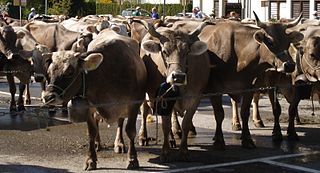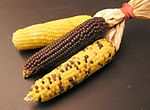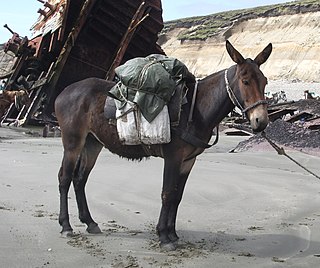
In biology, a hybrid is the offspring resulting from combining the qualities of two organisms of different breeds, varieties, species or genera through sexual reproduction. Hybrids are not always intermediates between their parents, but can show hybrid vigour, sometimes growing larger or taller than either parent. The concept of a hybrid is interpreted differently in animal and plant breeding, where there is interest in the individual parentage. In genetics, attention is focused on the numbers of chromosomes. In taxonomy, a key question is how closely related the parent species are.

Sweet corn is a hybridized variety of maize with a high sugar content. Sweet corn is the result of a naturally occurring recessive mutation in the genes which control conversion of sugar to starch inside the endosperm of the corn kernel. Unlike field corn varieties, which are harvested when the kernels are dry and mature, sweet corn is picked when immature and prepared and eaten as a vegetable, rather than a grain. Since the process of maturation involves converting sugar to starch, sweet corn stores poorly and must be eaten fresh, canned, or frozen, before the kernels become tough and starchy.

Popcorn is a variety of corn kernel which expands and puffs up when heated and the foodstuff produced from the expansion.

Polenta is a dish of boiled cornmeal that was historically made from other grains. It may be served as a hot porridge, or it may be allowed to cool and solidify into a loaf that can be baked, fried, or grilled.

A landrace is a domesticated, locally adapted, traditional variety of a species of animal or plant that has developed over time, through adaptation to its natural and cultural environment of agriculture and pastoralism, and due to isolation from other populations of the species. Landraces are generally distinguished from cultivars, and from breeds in the standardized sense, although the term landrace breed is sometimes used as distinguished from the term standardized breed when referring to cattle.

New Mexican cuisine is the cuisine of the Southwestern US state of New Mexico, the region is primarily known for its fusion of Pueblo Native American with Hispano Spanish and Mexican cuisine originating in Nuevo México. This cuisine had adaptions and influences throughout its history, including early on from the nearby Apache, Navajo, and throughout New Spain and the Spanish Empire, also from French, Italian, Mediterranean, Portuguese cuisine, and European cafés, furthermore during the American territorial phase from cowboy chuckwagons and Western saloons, additionally after statehood from Route 66 American diners, fast food restaurants, and global cuisine. Even so, New Mexican cuisine developed in fairly isolated circumstances, which has allowed it to maintain its indigenous, Spanish, and Mexican identity, and is therefore not like any other Latin food originating in the contiguous United States.
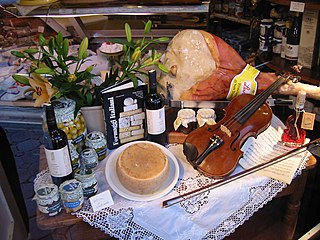
Italian cuisine is food typical of Italy. It has developed through centuries of social and economic changes, with roots stretching to antiquity.

Waxy corn or glutinous corn is a type of field corn characterized by its sticky texture when cooked as a result of larger amounts of amylopectin. The corn was first described from a specimen from China in 1909. As this plant showed many peculiar traits, the American breeders long used it as a genetic marker to tag the existence of hidden genes in other maize breeding programs. In 1922 a researcher found that the endosperm of waxy maize contained only amylopectin and no amylose starch molecule in opposition to normal dent maize varieties that contain both. Until World War II, the main source of starch in the USA was tapioca but when Japan severed the supply lines of the States, they forced processors to turn to waxy maize. Amylopectin or waxy starch is now used mainly in food products, but also in the textile, adhesive, corrugating and paper industry.

Genetically modified food controversies are disputes over the use of foods and other goods derived from genetically modified crops instead of conventional crops, and other uses of genetic engineering in food production. The disputes involve consumers, farmers, biotechnology companies, governmental regulators, non-governmental organizations, and scientists. The key areas of controversy related to genetically modified food are whether such food should be labeled, the role of government regulators, the objectivity of scientific research and publication, the effect of genetically modified crops on health and the environment, the effect on pesticide resistance, the impact of such crops for farmers, and the role of the crops in feeding the world population. In addition, products derived from GMO organisms play a role in the production of ethanol fuels and pharmaceuticals.

Commercial sorghum is the cultivation and commercial exploitation of species of grasses within the genus Sorghum. These plants are used for grain, fibre and fodder. The plants are cultivated in warmer climates worldwide. Commercial Sorghum species are native to tropical and subtropical regions of Africa and Asia.
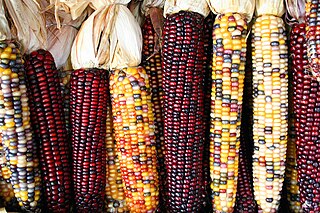
Flint corn is a variant of maize, the same species as common corn. Because each kernel has a hard outer layer to protect the soft endosperm, it is likened to being hard as flint; hence the name. The six major types of corn are dent corn, flint corn, pod corn, popcorn, flour corn, and sweet corn.

Barley, a member of the grass family, is a major cereal grain grown in temperate climates globally. It was one of the first cultivated grains, particularly in Eurasia as early as 10,000 years ago. Barley has been used as animal fodder, as a source of fermentable material for beer and certain distilled beverages, and as a component of various health foods. It is used in soups and stews, and in barley bread of various cultures. Barley grains are commonly made into malt in a traditional and ancient method of preparation.

Luigi Fenaroli was an Italian botanist and agronomist.
The varieties of Ecuadorian maize are the repository of a rich farming and cooking tradition.
The varieties of Bolivian maize are the result of thousands of years of selective breeding for superior agronomic and cooking traits.
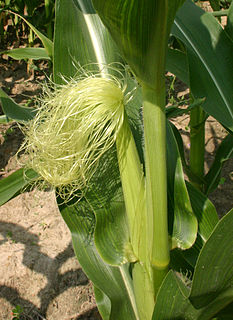
Corn silk is a common name for the shiny, thread-like, weak fibers that grow as part of ears of corn (maize); the tuft or tassel of silky fibers that protrude from the tip of the ear of corn. The ear is enclosed in modified leaves called husks. Each individual fiber is an elongated style, attached to an individual ovary. The term probably originated somewhere between 1850 and 1855.

Stenocarpella maydis (Berk.) Sutton is a plant pathogenic fungus and causal organism of diplodia ear and stalk rot. Corn and canes are the only known hosts to date. No teleomorph of the fungus is known.


